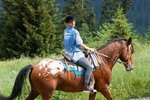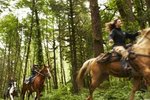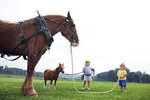Things You'll Need
Snaffle bridle (reins not needed)
Lead rope
Saddle or surcingle
Side reins
Dressage whip
Treats
Area with good footing and a wall or fence
Electrical tape or rubber band
Tips
When asking your horse to dance, stand tall and be focused. When giving your horse a break, relax and take your direct focus off your horse. This helps her know if she is supposed to be working or not.
You can try tapping anywhere on the lower leg. Some horses respond to low taps, others are best tapped near the hocks.
The Spanish walk--in which the horse moves forward with a flourish from the front legs--is an effective trick to teach prior to piaffe. It also involves tapping the legs for a response but is a little easier for the horse to learn.
Warnings
Working near horses can always be dangerous, especially when asking the horse to be exuberant. If he gets afraid or upset, have a professional help you before engaging in any further piaffe training.
The piaffe is a trot-like movement that a horse performs on the spot, and looks like a dance. A competition-quality piaffe takes years of training and strengthening for the horse to lower his haunches, shift his weight over his hindquarters, and raise his forehand, but any horse can learn the footfalls of a piaffe through trick training. Even some Grand Prix dressage horses have begun piaffe this way.
Warm up your horse with basic groundwork. Lead your horse at a trot and back her up. Move her shoulders and hips and ask her to put her head up and down.Your horse needs to respect you as her leader and understand that when you apply pressure she must figure out your request for the pressure to be released. If your horse does not move off feel easily-- or worse, moves into pressure--start with easier challenges and come back to the piaffe once your horse has learned to be a puzzle solver.
Put a halter on your horse and attach a lead rope. A simple halter and lead are sufficient for beginning piaffe training, but as you progress you will want to use a bridle and saddle or surcingle to connect one side rein on the horse's right side. You can use both side reins if you find it to be easier. The side reins connect from the ring of the snaffle to the girth or surcingle on the same side about 9 inches below the horse's back. Put a lead rope on the left snaffle ring. Tie her tail up and secure it with a rubber band or electrical tape so the tail is not in your way.
Stand your horse so the wall or fence is on his right. Stand on his left side near his shoulder or barrel. You need to be able to reach his hind legs with the dressage whip. Tap his hind left leg until he lifts it, then quit tapping and offer praise. Repeat this until your horse understands your request. If he lifts the leg nicely, or holds it up a little longer, give him a treat. You want the horse to immediately lift his leg as high as his fetlock and hold it for about two seconds. Repeat with the right leg; it is best to tap the back of the leg, but you can tap the front if you cannot reach the back of his right hind leg.
Work in sessions lasting no more than 10 minutes. It may take weeks until your horse gives consistent responses. If your horse gets frustrated and kicks out, ignore the bad behavior and reward only the desired behavior.
Put the bridle, surcingle or saddle, and side reins on your horse. Ask your horse to lift left, right, left and then praise. You want his response to be quick. If you ask the horse to keep going, he will quit trying, so be happy with left, right, left until he does it very well.
Trot him forward in-hand (leading the horse) a few steps after each repetition to energize him and make him think of the trot sequence of foot falls.
Tap your horse's haunches. Tap gently with the dressage whip to encourage her to creep forward just enough to get her front feet moving. You can also tap her front legs to give her the idea; her legs move in diagonal pairs, so tap the front left as the hind right leg is lifting. Lift her head if you need to get her lighter on her front feet, or lower her head if she gets tight and nervous. If she does one step that looks like a dance, reward her immediately and give her a break. Once she understands your request she will dance for longer periods of time to earn that carrot.
Tips
- When asking your horse to dance, stand tall and be focused. When giving your horse a break, relax and take your direct focus off your horse. This helps her know if she is supposed to be working or not.
- You can try tapping anywhere on the lower leg. Some horses respond to low taps, others are best tapped near the hocks.
- The Spanish walk--in which the horse moves forward with a flourish from the front legs--is an effective trick to teach prior to piaffe. It also involves tapping the legs for a response but is a little easier for the horse to learn.
Warnings
- Working near horses can always be dangerous, especially when asking the horse to be exuberant. If he gets afraid or upset, have a professional help you before engaging in any further piaffe training.




